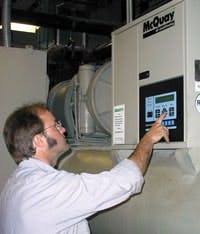Chillers often represent a plant's single largest electric load. A 600-ton chiller can draw 0.547 kW/ton, which, at a rate of $0.08 per kWh, adds up to more than $200,000 per year in operating costs. Factor in fouled tubes, leaking refrigerant, changes in water temperature and a myriad of other variables and operating costs can escalate by 8 to 10 percent an additional $20,000 per year. Operating a chiller at its peak performance saves energy as well as maintenance costs.
|
View more content on PlantServics.com |
Chiller efficiencies have improved significantly during the past 10 years, mostly as a result of new refrigerants and microprocessor controls, as well as improved compressor and motor design. However, high-tech chillers have narrower tolerances, so that service and upkeep are more crucial than ever for keeping them operating at peak performance.
Chiller performance varies significantly with operating conditions. Full-load performance is not a good indicator of overall performance, because chiller plants rarely operate at full load. Instead, part load performance is critical to good overall chiller plant performance. Consult ASHRAE Standard 90.1-2001, which lists minimum chiller efficiency requirements. Several variables affect chiller efficiency. Following are 10 tips that can help keep it riding high.
Keep a daily log
The daily log is still the first step in maintaining an efficiently run chiller plant. A log builds a history of operating conditions, including temperature, pressure, fluid level and flow rate. Although microprocessor controls are recording more of these statistics, there is no substitute for a written log detailing findings from daily inspection of controls in the chiller room.
Keep tubes clean
Heat transfer has the greatest single effect on chiller performance. Large chillers can have more than five miles of condenser and evaporator tubes, so high heat transfer is fundamental to maintaining efficiency.
Chiller efficiency declines rapidly when tubes become fouled. Contaminants, such as minerals, scale, mud, algae and other impurities, increase thermal resistance and reduce overall performance. These contaminants accumulate on the water side of heat transfer surfaces in both closed- and open-loop systems. Fouling occurs gradually over time, depending on the quality and temperature of the water used.
The compressor's approach temperature, the difference between the temperature of the fluid leaving the heat exchanger and the saturation temperature of the refrigerant being cooled or heated, is a good indicator of heat transfer efficiency. An increasing approach temperature is a prime indicator that heat transfer efficiency is decreasing. An accurate log sheet will reveal when temperatures start to change from efficient levels.
Condenser tubes should be brush cleaned, rather than chemically cleaned, at least annually with an automatic rotary-cleaning machine to keep them free of contaminants.
Treat condenser water
Condenser water loops using open cooling sources, such as atmospheric cooling towers, require water treatment to prevent fouling. Erosive conditions, for example, sand flowing through the tubes at high velocity, may pit tubes, decreasing tube effectiveness. Untreated water can damage tubes, piping and other materials.
A cooling tower bleed or blowdown is the most effective way to remove solids and contaminants. When a sensor detects high water conductivity, an automatic valve dumps some water and its load of dissolved and suspended solids.
A visual inspection also is a good, although less accurate, indicator of water quality. Inspect chilled water loops once a year for general water quality and evidence of corrosion.
Reduce entering water temperature
Lowering the temperature of the water entering the condenser can improve the chiller's efficiency. On some building systems, operators can reduce the chilled water setpoint to overcome air handler deficiencies such as dirty coils. Beware of this practice, which may stop the symptoms but won't cure the problem. It makes the chiller work harder for the same net cooling effect.
Mark Hanson, service technician, finishes a maintenance job on a centrifugal chiller by verifying that actual conditions match performance specifications.
Control water velocity
Flow rate must be regulated closely, because too low a flow rate reduces chiller efficiency, leading to laminar flow. The minimum flow rate is typically around 3 ft. per second. However, too high a flow rate leads to vibration, noise and tube erosion. The maximum recommended flow rate is typically around 12 ft. per second.
Maintain refrigerant charge
The amount of cooling that any chiller can provide depends on how much refrigerant it moves through the compressor per unit time. It's important to maintain the proper level of refrigerant.
Leaks, as well as air and moisture, decrease efficiency and system reliability. Low refrigerant charge, usually resulting from leaks, causes the compressor to work harder and achieve less cooling effect.
Purge non-condensables
Air and moisture are two non-condensables that can leak into low-pressure chillers. Non-condensables can reduce chiller efficiency by as much as 4% at 60% load and 7% at 100% loads.
Air insulates tubes, preventing exchange and elevating condensing temperatures, which also makes the compressor work harder. Moisture promotes acid formation, which can damage motor windings and bearings.
Installing purge units on low-pressure chillers minimizes the effect of non-condensables. Modern, high-efficiency purge units minimize both air ingress and refrigerant loss.
Eventually, positive pressure chillers using HFC-134a, HFC-410a and HCFC-22 will replace low-pressure chillers. The newer units don't require purge units because non-condensables can't enter them.
Analyze compressor oil
Once a year, send a sample of the compressor lube oil to a laboratory for a spectrometric chemical analysis that will provide details about moisture content, metals, acids and other contaminants that affect performance. Oil should be replaced only if necessary.
High moisture levels can indicate a purge unit problem, which has a significant effect on efficiency. Pull samples from low-pressure chillers more frequently, using a schedule based on purge run hours. Replace oil filters when they exhibit a high pressure drop and when the oil charge is replaced.
Check wiring
For efficient starter and motor operation, check the safety and sensor calibrations on microprocessor controls. Consult manufacturer's guidelines. Then check chiller electrical connections, wiring and switchgear for hot spots and worn contacts. To prevent insulation faults, test motor windings for resistance to ground and winding-to-winding. Check the shaft seal on open drive motors for possible refrigerant leaks, and clean motor cooling air vents to maximize cooling.
Modulate speed
A chiller motor is typically the largest single electrical load in a building. Constant-speed compressors match capacity to load through inlet vanes, throttling the gas allowed into the compressor impellers. This is not the most efficient way to modulate chiller capacity.
Under the right operating conditions, variable speed drives offer significant energy savings. Variable speed drives also act as "soft starters" to reduce the motor's inrush current to almost that of the full-load running amps. This reduction is important for chillers operating on emergency power generators. Variable speed drives also reduce the mechanical shock of starting large horsepower motors, increasing chiller reliability and life.
Richard Grenz is national sales and marketing manager for McQuayService in Minneapolis. Call him at (763) 553-5330.



